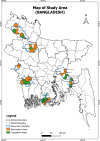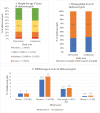Water, sanitation and hygiene (WASH) practices and deworming improve nutritional status and anemia of unmarried adolescent girls in rural Bangladesh
- PMID: 37957706
- PMCID: PMC10644610
- DOI: 10.1186/s41043-023-00453-8
Water, sanitation and hygiene (WASH) practices and deworming improve nutritional status and anemia of unmarried adolescent girls in rural Bangladesh
Erratum in
-
Correction to: Water, sanitation and hygiene (WASH) practices and deworming improve nutritional status and anemia of unmarried adolescent girls in rural Bangladesh.J Health Popul Nutr. 2024 Jun 27;43(1):99. doi: 10.1186/s41043-024-00579-3. J Health Popul Nutr. 2024. PMID: 38937851 Free PMC article. No abstract available.
Abstract
Background: In Bangladesh, undernutrition and anemia are more occurrent among adolescent girls. BRAC, the largest non-governmental organization (NGO), has been implementing a community-based nutrition education service package targeting adolescent girls for reducing their undernutrition and anemia.
Objective: We aimed to explore the underlying factors associated with nutritional status and anemia among adolescent girls under the BRAC nutrition program areas to improve their existing intervention package.
Methodology: We conducted a cross-sectional and comparative study in 2016, in 24 upazilas of Bogra, Barguna, Comilla, Dinajpur, Feni, Jessore, and Meherpur districts where the BRAC nutrition program was implemented while the remaining 27 upazilas of those districts were selected as comparison area. We followed a multistage cluster random sampling for selecting 1620 unmarried adolescent girls aged 10-19 years for interviewing in the intervention and comparison areas. Data were collected on socio-demographic information, dietary intake, morbidity, water, sanitation, and hygiene (WASH) practice, anthropometry, and serum hemoglobin (Hb) level by using a pre-structured questionnaire. The nutritional status of the adolescent girls was expressed as height-for-age Z (HAZ) and body mass index-for-age Z (BMIZ) score, while anemia referred to the serum Hb at the level of below 12 g/dl for adolescent girls. All statistical analyses were done in STATA version 17 (Chicago Inc.).
Findings: The prevalence of stunting (22.9% vs. 22.5%), thinness (12% vs. 14%), and anemia (34.5% vs. 37.3%) exhibited similarities between the intervention and comparison regions. Stunting and thinness were predictors for each other for this population group. Our findings indicated that adolescent girls who were not washing hands with soap after defecation were likely to be stunted [AOR 1.51 (95% CI 1.12-2.04)], and who did not utilize sanitary latrines had an increased likelihood of being thin [AOR 2.38 (95% CI 1.11-5.08)]. Conversely, those who did not watch television [AOR 1.69 (95% CI 1.12-2.56)] and did not have deworming tablets [AOR 1.33 (95% CI 1.07-1.64)] in the 6 months leading up to the interview had a 69% and 33% higher probability of being anemic, respectively.
Conclusion: For sustainable improvement in the undernutrition and anemia of adolescent girls, integration of WASH, consistent administration of deworming tablets and broadcasting awareness programs through television are urgent to scale up the nutrition intervention programs in similar settings like Bangladesh.
Keywords: Adolescent girls; Anemia; Bangladesh; Deworming; Nutritional status; Rural; WASH.
© 2023. The Author(s).
Conflict of interest statement
The authors declare that they have no competing interests.
Figures
References
-
- Caleyachetty R, Thomas GN, Kengne AP, Echouffo-Tcheugui JB, Schilsky S, Khodabocus J, et al. The double burden of malnutrition among adolescents: analysis of data from the Global School-Based Student Health and Health Behavior in School-Aged Children surveys in 57 low- and middle-income countries. Am J Clin Nutr. 2018;108(2):414–424. doi: 10.1093/ajcn/nqy105. - DOI - PubMed
-
- De K. A comparative study on nutritional status of adolescents girls of different rural area of West Bengal. Anthropology. 2016;04(04).
-
- Caleyachetty R, Thomas GN, Kengne AP, Echouffo-Tcheugui JB, Schilsky S, Khodabocus J, et al. The double burden of malnutrition among adolescents: analysis of data from the Global School-Based Student Health and Health Behavior in School-Aged Children surveys in 57 low- and middle-income countries. Am J Clin Nutr. 2018;108(2):414–424. doi: 10.1093/ajcn/nqy105. - DOI - PubMed
-
- Bangladesh Bureau of Statistics, Ministry of Planning. Population Census. Dhaka; 2011.
Publication types
MeSH terms
Substances
LinkOut - more resources
Full Text Sources
Medical




